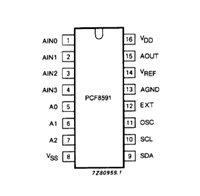NMOS linear image sensor S3921/S3924 series
Figure 2 shows the schematic diagram of the photodiode
must be held at “High” at least 200 ns. Since the photodiode
signal is obtained at the rise of each φ2 pulse, the clock pulse
frequency will equal the video data rate.
active area. This active area has a PN junction consisting of
an N-type diffusion layer formed on a P-type silicon substrate.
A signal charge generated by light input accumulates as a
capacitive charge in this PN junction. The N-type diffusion
layer provides high UV sensitivity but low dark current.
The amplitude of start pulse φst is the same as the φ1 and φ2
pulses. The shift register starts the scanning at the “High”
level of φst, so the start pulse interval is equal to signal accu-
mulation time. The φst pulse must be held “High” at least 200
ns and overlap with φ2 at least for 200 ns. To operate the shift
register correctly, φ2 must change from the “High” level to the
“Low” level only once during “High” level of φst. The timing
chart for each pulse is shown in Figure 7.
ꢀꢀDriver circuit
A start pulse φst and 2-phase clock pulses φ1, φ2 are needed
to drive the shift register. These start and clock pulses are
positive going pulses and CMOS logic compatible.
The 2-phase clock pulses φ1, φ2 can be either completely
separated or complementary. However, both pulses must not
be “High” at the same time.
A clock pulse space (X1 and X2 in Figure 7) of a “rise time/fall
time - 20” ns or more should be input if the rise and fall times
of φ1, φ2 are longer than 20 ns. The φ1 and φ2 clock pulses
ꢀꢀEnd of scan
The end of scan (EOS) signal appears in synchronization
with the φ2 timing right after the last photodiode is addressed,
and the EOS terminal should be pulled up at 5 V using a 10
kΩ resistor.
Figure 7 Timing chart for driver circuit
Figure 8 Reset V voltage margin
tpw
s
V
V
s (H)
s (L)
12
st
tpw
1
V
V
V
V
1 (H)
1 (L)
2 (H)
2 (L)
1
2
tpw
2
10
8
Vr (H)
Vr (L)
RESET
tvd
ACTIVE VIDEO OUTPUT
END OF SCAN
6
4
RESET V VOLTAGE RANGE
tr
s
tf s
st
2
tr
1
tf
1
MIN.
1
2
tf
2
X1
X2
0
4
5
6
7
8
9
10
t
ovr td r-2
t
ov
ts r-2
CLOCK PULSE AMPLITUDE (V)
RESET
KMPDB0047EA
tfr
trr
KMPDC0026EA
ꢀꢀSignal readout circuit
S3921/S3924 series include a current integration circuit uti-
lizing the video line capacitance and an impedance conver-
sion circuit. This allows signal readout with a simple external
circuit. However, a positive bias must be applied to the video
line because the photodiode anode of NMOS linear image
sensors is at 0 V (Vss).This is done by adding an appropriate
pulse to the reset φ terminal. The amplitude of the reset pulse
should be equal to φ1, φ2 and φst.
When the reset pulse is at the high level, the video line is set
at the Reset V voltage. Figure 8 shows the Reset V voltage
margin. A higher clock pulse amplitude allows higher Reset
V voltage and saturation charge. Conversely, if the Reset V
voltage is set at a low level with a higher clock pulse ampli-
tude, the rise and fall times of video output waveform can be
shortened. Setting the Reset V voltage to 2.5 V is recom-
mended when the amplitude of φ1, φ2, φst and Reset φ is 5 V.
To obtain a stable output, an overlap between the reset pulse
(Reset φ) and φ2 must be settled. (Reset φ must rise while φ2
is at the high level.) Furthermore, Reset φ must fall while φ2 is
at the low level.
S3921/S3924 series provide output signals with negative-
going boxcar waveform which include a DC offset of approxi-
mately 1 V when Reset V is 2.5 V. If you want to remove the DC
offset to obtain the positive-going output, the signal readout
circuit and pulse timing shown in Figure 9 are recommended.
In this circuit, Rs must be larger than 10 kΩ. Also, the gain is
determined by the ratio of Rf to Rs, so choose the Rf value
that suits your application.






 STM32F030C6芯片介绍:主要参数分析、引脚配置说明、功耗及封装
STM32F030C6芯片介绍:主要参数分析、引脚配置说明、功耗及封装

 PCF8591数据手册解读:参数、引脚说明
PCF8591数据手册解读:参数、引脚说明

 一文带你了解ss8050参数、引脚配置、应用指南
一文带你了解ss8050参数、引脚配置、应用指南

 深入解析AD7606高性能多通道模数转换器:资料手册参数分析
深入解析AD7606高性能多通道模数转换器:资料手册参数分析
